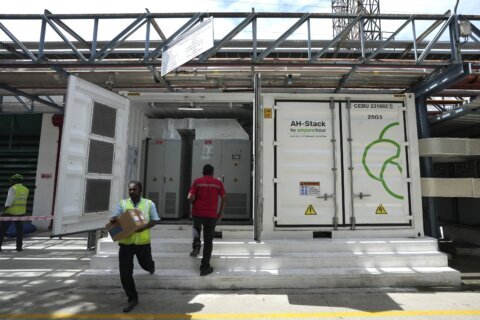Mortgage rates inched slightly higher this week, with the average 30-year fixed rate increasing to 7.14%. Most fixed and adjustable rates stayed about the same as the prior week or crept upward by a few basis points.
Here are the current mortgage rates, without discount points unless otherwise noted, as of June 15:
— 30-year fixed: 7.14% (up from 7.11% a week ago).
— 20-year fixed: 7.07% (up from 7.06% a week ago).
— 15-year fixed: 6.54% (down from 6.55% a week ago).
— 10-year fixed: 6.65% (up from 6.63% a week ago).
— 5/1 ARM: 6.08% (up from 6.02% a week ago).
— 7/1 ARM: 6.21% (up from 6.19% a week ago).
— 10/1 ARM: 6.43% (up from 6.38% a week ago).
— 30-year jumbo loans: 7.22% (up from 7.16% a week ago).
— 30-year FHA loans: 6.32% with 0.05 point (down from 6.34% a week ago).
— VA purchase loans: 6.6% with 0.04 point (up from 6.58% a week ago).
“As inflation continues to decelerate, economic growth is slowing and the tightening cycle of monetary policy is reaching its apex, which means mortgage rates are expected to decrease later this year and into next.”
— Sam Khater, Freddie Mac’s chief economist, in a June 15 statement
In light of a cooling economy and slowing inflation, as evidenced by Tuesday’s consumer price index report, the Federal Open Market Committee voted to skip a hike to the benchmark federal funds rate at its June meeting. But this decision wasn’t the only thing forecasters were keeping an eye on this week.
The FOMC also released updated economic projections, showing that it expects core inflation (consumer prices of all items minus food and energy) to run higher than originally thought: 3.9% by the end of the year, adjusted higher from 3.6% previously. As a result, Fed officials project the federal funds rate will end the year a half-percentage point higher than what it is currently — signaling that policymakers anticipate additional rate hikes before the end of the year.
“Changes to the Fed’s projections signal continued vigilance on inflation, and in particular on core inflation, which has not abated as much as headline inflation in recent months,” says Realtor.com chief economist Danielle Hale. “This is a reminder to the market that the Fed remains dependent on incoming data and will not shy away from a tighter course of policy, if warranted.”
While the annual inflation rate slowed to 4% in May — the lowest reading since March 2021 — core inflation remained elevated at 5.3%.
“The market had previously priced in rate cuts by the end of 2023, so there will be an adjustment to these new expectations that could put some upward pressure on interest rates in the near term, but the Fed’s focus on fighting inflation should boost confidence in that outcome in the medium to long term,” Hale says.
The Fed’s latest projections go against expectations from economists who believed the central bank may have reached its terminal rate. Lawrence Yun, chief economist at the National Association of Realtors, says further rate hikes are unnecessary given the lag between policy decisions and their economic impacts.
“There is no need to consider raising interest rates,” Yun says. “In fact, considering the balance sheet difficulties faced by community banks and weakness in the commercial real estate sector, the Fed should look at cutting interest rates before the end of the year. The Fed should look forward, not backward.”
[Compare: Compare Mortgage Rates]
Indicator of the Week: The Case for Renting in Today’s Market
Armchair economists and wannabe real estate investors have a habit of shaming renters for “throwing money away” when they should be building wealth through the American dream of homeownership. But the reality is that owning your own home isn’t necessarily an investment vehicle. While houses tend to appreciate over long periods (think 10 to 20 years), they can also lose value — especially if you plan on buying and selling within the span of a few short years.
It’s easy to debunk another anti-renter myth: “Rent always goes up, but mortgage payments stay the same.” That may be true when it comes to principal and interest payments, which are usually fixed during the loan term, but other mortgage costs like property taxes, home insurance premiums and homeowners association fees tend to increase over time.
The variable costs of homeownership have been steadily creeping higher. Property tax bills are rising in step with the rapid home price appreciation over the past few years. Annual homeowners insurance premiums are projected to rise by 9% this year, according to the insurance marketplace Insurify — and that’s on top of a 7% increase last year.
Especially in today’s high-interest-rate environment, homeownership is becoming less financially attractive. It may have been cheaper to buy a home than to rent when mortgage rates were around 3%, but that’s certainly not true anymore. The monthly mortgage payment needed to buy a first home today far exceeds the typical market rent when you run the numbers.
In May, asking rents reached a record high of $2,048, according to Zillow data. Even still, the monthly mortgage payment on the typical home worth $346,270 would be much higher at $2,537 — that includes a 10% down payment, which is generous considering that most first-time homebuyers put between 6% and 7% down, NAR research shows. Here’s how that would break down:
— Loan amount: $311,643. That’s after a 10% down payment of $34,627.
— Mortgage rate: 6.43%. This was Freddie Mac’s average 30-year fixed rate during the month of May.
— Principal and interest payment: $1,955. You can use a mortgage calculator to play around with the numbers.
— Property tax: $317. This is assessed at a property tax rate of 1.1% of the home’s value, but it varies based on location.
— Home insurance: $135. A U.S. News analysis found that home insurance premiums average between $100 and $170 per month.
— Mortgage insurance: $130. And that’s even after FHA lowered its mortgage insurance premiums this year.
— Total monthly payment: $2,537. Not including HOA fees, home repairs, higher utility bills and other hidden joys of homeownership.
That’s not to say that homeownership is a bad financial move, or that renting is the best strategy for everyone. But renters shouldn’t feel less-than just because they don’t own a home, whether that’s because they can’t afford to or they simply don’t want to.
If someone is willing to buy a home in this market — one that requires buyers to bid over asking price, waive inspection contingencies and pay a 7% mortgage rate — they have to really want to be a homeowner. For those who would rather wait for better market conditions or just skip homebuying altogether, renting is just fine.
More from U.S. News
Mortgage Rates Tumble — But Still Linger Over 7%
Spring Mortgage Forecast: Rates Will Stay Above 6%
Two-Thirds of Homebuyers Are Holding Out for Lower Rates
Mortgage Rates Rise, Pushing Housing Payments to New Heights originally appeared on usnews.com







